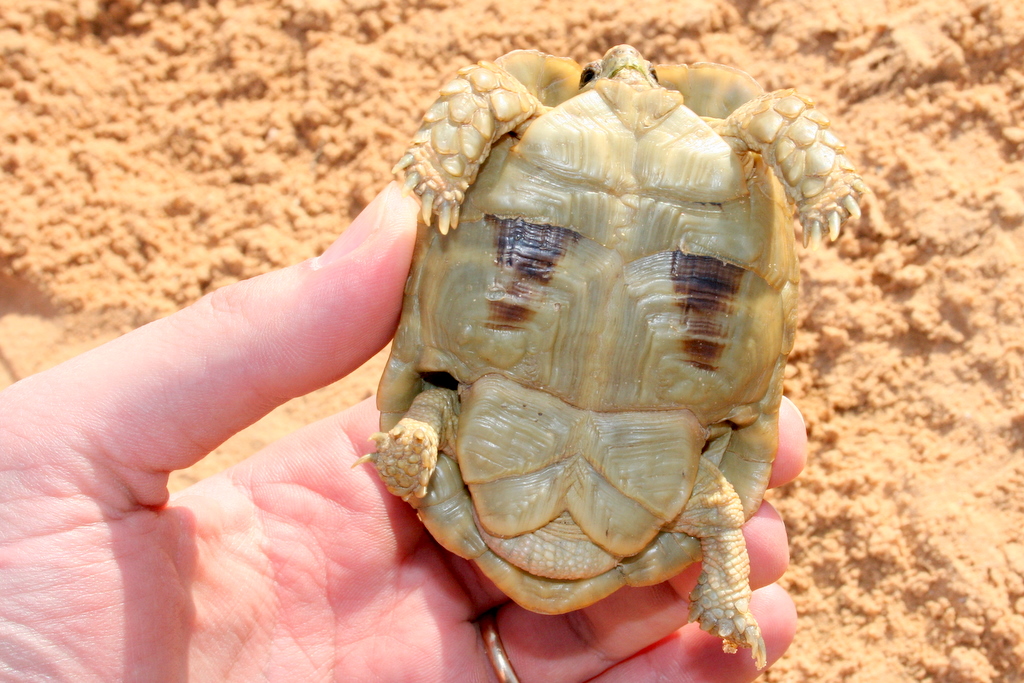|
Solitudo
''Solitudo'' is an extinct genus of tortoise that was found during the Pliocene and Pleistocene on the Mediterranean islands of Menorca, Malta and Sicily. The genus includes three described species, ''Solitudo robusta'', ''Solitudo gymnesica'' and ''Solitudo sicula'' as well as a likely fourth, undescribed species from Monte Pellegrino in Sicily. ''Solitudo sicula'', the youngest of the species, died out approximately 12.5 thousand years Before Present, BP. The largest species, ''Solitudo gymnesica'', has been estimated to have reached a carapace length of . History The oldest discoveries of fossil turtles now included under ''Solitudo'' were made in the 19th century, with Leith-Adams describing remains from Zebbug Cave (Malta) as ''Testudo robusta''. In 1914 ''Testudo gymnesica'' was described based on Pliocene material found on Menorca. Younger material was later discovered in the Zubbio di Cozzo San Pietro cave in northern Sicily. These remains, which include a femur, phalanx ... [...More Info...] [...Related Items...] OR: [Wikipedia] [Google] [Baidu] |
Tortoise
Tortoises ( ) are reptiles of the family Testudinidae of the order Testudines (Latin for "tortoise"). Like other turtles, tortoises have a shell to protect from predation and other threats. The shell in tortoises is generally hard, and like other members of the suborder Cryptodira, they retract their necks and heads directly backward into the shell to protect them. Tortoises can vary in size with some species, such as the Galápagos giant tortoise, growing to more than in length, whereas others like the Speckled cape tortoise have shells that measure only long. Several lineages of tortoises have independently evolved very large body sizes in excess of , including the Galapagos giant tortoise and the Aldabra giant tortoise. They are usually diurnal animals with tendencies to be crepuscular depending on the ambient temperatures. They are generally reclusive animals. Tortoises are the longest-living land animals in the world, although the longest-living species of tortois ... [...More Info...] [...Related Items...] OR: [Wikipedia] [Google] [Baidu] |
Trochanter
A trochanter is a tubercle of the femur near its joint with the hip bone. In humans and most mammals, the trochanters serve as important muscle attachment sites. Humans have two, sometimes three, trochanters. Etymology The anatomical term ''trochanter'' (the bony protrusions on the femur) derives from the Greek τροχαντήρ (''trochantḗr''). This Greek word itself is generally broken down into: * τροχάζω (''trokházō''), meaning “to run quickly,” “to gallop,” or “to move rapidly.” * -τήρ (''-tḗr''), a suffix in Greek that often signifies an agent or instrument (“one who oes something�� or “that which oes something��). While the exact origin of the anatomical term trochanter is uncertain, multiple possible connections could be suggested. One possibility is that the term was derived directly from the Greek roots without influence from the maritime meaning, with the name referencing the trochanter’s role in enabling swift movement throu ... [...More Info...] [...Related Items...] OR: [Wikipedia] [Google] [Baidu] |
African Spurred Tortoise
The African spurred tortoise (''Centrochelys sulcata''), also called the sulcata tortoise, is an endangered species of tortoise inhabiting the southern edge of the Sahara, Sahara Desert, the Sahel, in Africa. It is the largest mainland species of tortoise in Africa, and the third-largest in the world, after the Galapagos tortoise and Aldabra giant tortoise. It is the only living species in its genus, ''Centrochelys.'' Taxonomy and etymology In 1779 the English illustrator John Frederick Miller included a hand-coloured plate of the African spurred tortoise in his ''Icones animalium et plantarum'' and coined the binomial name ''Testudo sulcata''. Its Species, specific name ''sulcata'' is from the Latin word ''sulcus'' meaning "furrow" and refers to the furrows on the tortoise's scales. The species was subsequently given other binomial names. There are no recognized subspecies despite there being two separate populations, one in Western Africa and the other in Eastern Africa. Ther ... [...More Info...] [...Related Items...] OR: [Wikipedia] [Google] [Baidu] |
Leopard Tortoise
The leopard tortoise (''Stigmochelys pardalis'') is a large and attractively marked tortoise found in the savannas of eastern and southern Africa, from Sudan to the southern Cape Province. It is the only extant member of the genus ''Stigmochelys'', although in the past, it was commonly placed in '' Geochelone''. This tortoise is a grazing species that favors semiarid, thorny to grassland habitats. In both very hot and very cold weather, it may dwell in abandoned fox, jackal, or aardvark burrows. The leopard tortoise does not dig other than to make nests in which to lay eggs. Given its propensity for grassland habitats, it grazes extensively upon mixed grasses. It also favors succulents and thistles. Taxonomy and etymology The phylogenic placement of the leopard tortoise has been subject to several revisions. Different authors have placed it in ''Geochelone'' (1957), ''Stigmochelys'' (2001), ''Centrochelys'' (2002), and ''Psammobates'' (2006). More recently, consensus appears to h ... [...More Info...] [...Related Items...] OR: [Wikipedia] [Google] [Baidu] |
Egyptian Tortoise
Kleinmann's tortoise (''Testudo kleinmanni''), also called commonly the Egyptian tortoise, Leith's tortoise, and the Negev tortoise, is a critically endangered species of cryptodire turtle in the family Testudinidae. The species is native to Libya and possibly extinct in Egypt. The species was once more widespread, but its numbers are now dwindling, and complete extinction in the wild is a looming threat unless more actions are taken to protect this species. Etymology The specific name, ''kleinmanni'', is in honor of , a French stockbroker who collected the holotype in 1875. The specific name, ''werneri'' (of the synonym ''Testudo werneri)'', is in honor of Israeli herpetologist Yehudah L. Werner. Description Kleinmann's tortoise is the smallest tortoise in the Northern Hemisphere. Females are larger than males; males are more slender and have a longer tail. The carapace has a high dome, and ranges in color from ivory to pale gold to dark brown to pink or dull yellow. Th ... [...More Info...] [...Related Items...] OR: [Wikipedia] [Google] [Baidu] |
Greek Tortoise
Greek tortoise (''Testudo graeca''), also known as the spur-thighed tortoise or Moorish tortoise, is a species of tortoise in the family Testudinidae. It is a medium sized herbivorous testudinae, widely distributed in the Mediterranean basin, Mediterranean region. ''Testudo graeca'' is recognized for its longevity, with verified lifespans exceeding 100 years and anecdotal reports suggesting ages over 125 years. Among reptiles, it has one of the largest known genomes. Geographic range The geographic distribution of the Greek tortoise (''Testudo graeca'') includes North Africa, Southern Europe, and Western Asia, Southwest Asia. It is commonly found along the Black Sea Caucasian Riviera, coast of the Caucasus, extending from Anapa, Russia, to Sukhumi, Abkhazia, Georgia (country), Georgia. Additional populations are present in parts of Georgia (country), Georgia, Armenia, Iran, and Azerbaijan. Evolution The oldest confirmed fossil attributed to ''Testudo graeca'' originates from ... [...More Info...] [...Related Items...] OR: [Wikipedia] [Google] [Baidu] |
Russian Tortoise
The Russian tortoise (''Testudo horsfieldii)'', also commonly known as the Afghan tortoise, the Central Asian tortoise, the four-clawed tortoise, the four-toed tortoise, Horsfield's tortoise, the Russian steppe tortoise, the Soviet Tortoise, and the steppe tortoise, is a threatened species of tortoise in the family Testudinidae. The species is endemic to Central Asia from the Caspian Sea south through Iran, Pakistan and Afghanistan, and east across Kazakhstan to Xinjiang, China. www.reptile-database.org. Human activities in its native habitat contribute to its threatened status. Two Russian tortoises were the first Earth inhabitants to travel to and circle the Moon, on Zond 5 in September 1968. Etymology Both the specific name, ''horsfieldii'', and the common name "Horsfield's tortoise" are in honor of the American naturalist Thomas Horsfield. He worked in Java (1796) and for the East India Company and later became a friend of Sir Thomas Raffies. xiii + 296 pp. (''Testudo ho ... [...More Info...] [...Related Items...] OR: [Wikipedia] [Google] [Baidu] |
Hermann's Tortoise
The Hermann's tortoise (''Testudo hermanni)'' is a species of tortoise native to Europe. Etymology The specific epithet, ''hermanni'', honors French naturalist Johann Hermann. Beolens, Bo; Watkins, Michael; Grayson, Michael (2011). ''The Eponym Dictionary of Reptiles''. Baltimore: Johns Hopkins University Press. xiii + 296 pp. . (''Testudo hermanni'', p. 121; ''T. h. boettgeri'', p. 29). The subspecific name, ''boettgeri'', honors German herpetologist Oskar Boettger. Taxonomy Two subspecies are known: the western Hermann's tortoise (''T. h. hermanni)'' and the eastern Hermann's tortoise (''T. h. boettgeri)''. Sometimes mentioned as a subspecies, ''T. h. peleponnesica'' is not yet confirmed to be genetically different from ''T. h. boettgeri''. In 2006, Hermann's tortoise was suggested to be moved to the genus ''Eurotestudo'' and to bring the subspecies to the rank of species (''Eurotestudo hermanni'' and ''Eurotestudo boettgeri)''. Although some factors indicate this might ... [...More Info...] [...Related Items...] OR: [Wikipedia] [Google] [Baidu] |
Testudininae
Tortoises ( ) are reptiles of the family Testudinidae of the order Testudines (Latin for "tortoise"). Like other turtles, tortoises have a shell to protect from predation and other threats. The shell in tortoises is generally hard, and like other members of the suborder Cryptodira, they retract their necks and heads directly backward into the shell to protect them. Tortoises can vary in size with some species, such as the Galápagos giant tortoise, growing to more than in length, whereas others like the Speckled cape tortoise have shells that measure only long. Several lineages of tortoises have independently evolved very large body sizes in excess of , including the Galapagos giant tortoise and the Aldabra giant tortoise. They are usually diurnal animals with tendencies to be crepuscular depending on the ambient temperatures. They are generally reclusive animals. Tortoises are the longest-living land animals in the world, although the longest-living species of tortoise is ... [...More Info...] [...Related Items...] OR: [Wikipedia] [Google] [Baidu] |






